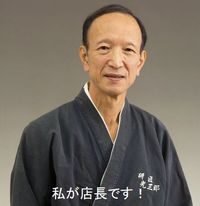| 包丁の研ぎ方 |
Blade Sharpening |
|
| ①まず研ぐ前に砥石を水に入れて砥石から気泡が出なくなるまで待ちます。(約20分位)※(最近では①の必要がない砥石もあります。)
②砥石が動かないようにぬれた雑巾を敷いたり砥石台などで固定して研ぎやすいように手前を2〜3cmぐらい高くします。(図1)
③利腕の中指、薬指、小指の3本で柄をしっかり握り、人差し指は包丁の背、親指は包丁の裏側の刃寄りに添える。
④利腕の逆手の人差し指、中指、薬指の3本も包丁の裏側の刃寄りに添える。(図1)
⑤③④の状態で前へ押すときに力を入れ、手前に引くときは力を抜きます。これを包丁の裏側にかえりが出るまで反復します。
(この時利腕の手首を動かさないようにします。)
⑥かえりが出たら包丁を裏返し、今度は引くときに力を入れて、押すときに力を抜きます。両刃の包丁の場合は㈭の時と同じ位反復し、片刃の場合はかえりが取れたら出来上がりです。 |
[1] First soak the sharpening stone. Most stones should be soaked between 10-20 mins. Specialized stones will require varying soak times or none at all.
[2] Grip the blade firmly (see picture on right). With the blade facing you and using your right hand, hold the handle of the blade comfortably, yet firmly. With your left hand, use 2-3 fingers on the blade approximately 2-3cm above the blade edge.
Press down to find the angle of the cutting edge on the blade so that it is flat on the stone.
[3] Firmly push the blade upwards then lightly pull the blade back downwards. Use firm and smooth strokes for each movement.
Be sure to hold the blade at the same angle on every strokes. After about 3-5 stroke, move the blade slightly over and sharpen the next area of the blade. Repeat until the entire blade is sharpened.
[4] When done, there will be a rough edge (called the “burr”) on the backside of the blade that needs to be smoothed off. Turn the blade over and lay it flat on its cutting edge against the stone. Firmly push the blade upwards. Release pressure on the down stroke and continue for the entire length of the knife. See below for more details. |
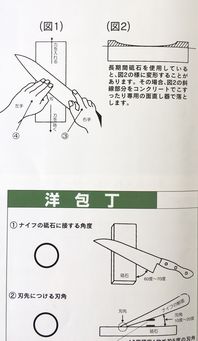 |
|
Proper Holding Form when Sharpening |
|
|
Side View of Sharpening Stone |
|
|
Constant sharpening will cause the center portion of the stone to wear down. |
|
| 和包丁【柳刃・蛸引・薄刃】 |
Sharpening Thin Japanese Style Blades (Yanegi, Takobiki, and Usuba Blades) |
|
|
For Sashimi |
|
| 柳刃・蛸引・薄刃などは、和包丁のうちでもとくに切れ味のよい刃物です。したがってシャープな切れ味を殺さずに研ぐためには、細心の注意が必要です。 |
Removing burr off of Japanese blades is difficult because the back edge of the blade is curved and also because there is another edge on the back that needs to be maintained. |
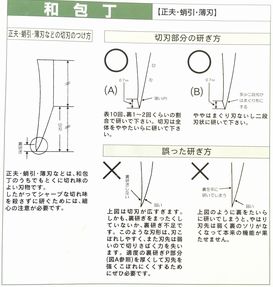 |
|
Correct |
|
| 表10回、裏1~2回くらいの割合で研いで下さい。切刃は全体をややたいらに研いで下さい。 |
Make sure to maintain the curvature and cutting edge of the back side of the knife by properly maintaining solid contact between the back edge and the sharpening stone. |
|
|
Not correct |
|
| 上図は切刃が広すぎます。しかも、裏研ぎをまったくしていないか、裏研ぎ不足です。このような刃形は、刃こぼれしやすく、また刃先は弱いので切りさばく力を失います。適度の裏研ぎP部分(図A参照)を厚くして刃先を強くこぼれにくくするためにぜひ必要です。 |
Be careful not to over grind the back edge of the knife. Doing so will flatten the curve. This will permanently damage your knife. |
|
| 和包丁【出刃】 |
Sharpening Thick Japanese Style knives (Deba and Yodeba blades) |
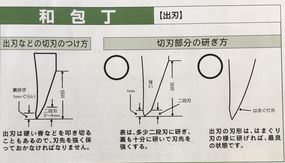 |
|
For Deba |
| 出刃は硬い骨などを叩き切ることもあるので、刃先を強く保っておかなければなりません。 |
Deba and Yodeba blades are designed to cut thick foods (meat, bones, etc) and must be sharpened differently from Yanagi-like blades. |
|
Correct |
| 表は、多少二段刃に研ぎ、裏も十分に研いで刃先を強くする。 |
The cutting edge must be sharpened at a wider angle. Too thin of an angle (Like the Yanagi blades) will cause the blade edge to chip when cutting. |
| 絶対にしてはいけないベタ研ぎ |
Things NEVER to do when Sharpening |
|
| 表・裏とも刃角を付けないベタ研ぎをしますと刃先の強度がなくなり、刃こぼれの原因となり、また物を切りさばく力もなくなります。絶対にしないで下さい。 |
DO NOT use hard cutting boards with Honyaki knives as this will dull or chip the blades very easily Always use soft cutting boards. |
|
| ナイフの刃面全部を砥石に付けて研ぐこと |
Do not lay the knife flat against the sharpening stone. |
|
|
|
|
|
|
|
| 洋包丁 |
Sharpening Western Style Knives |
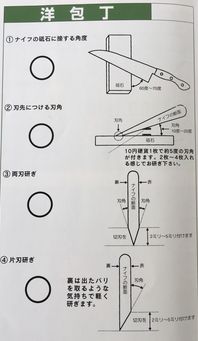 |
|
Top view |
|
Hold the knife at a 60-70 degree angle when sharpening. |
|
Side view |
|
Hold the blade between 10-20 degrees above the stone. |
|
Double edge |
|
When sharpening a double edged knife with equal cutting angles, make sure to sharpen both sides equally. The sharpening edge is 2-5mm from the tip of the knife. |
|
Single edge |
|
|
When sharpening a single edged knife, make sure to sharpen only 2-5mm from the tip of the knife. |
|
|
|
|
|
|
|
|
|
|
|
|
|
|
|
|
|
|
|
|
|
|

